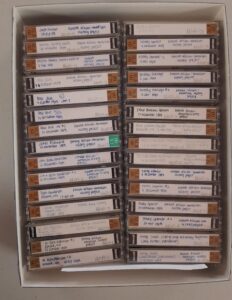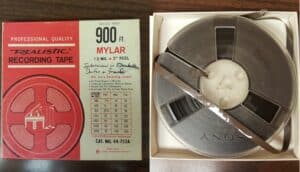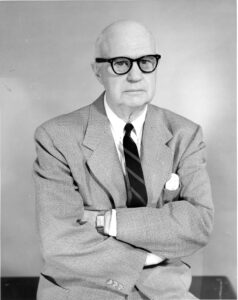Listening and Learning
By Becky Chapin, Archivist

Cassette tapes created from interviews by Kathryn Grover with members of Geneva’s African American community. Today, our oral history interviews for the Make a Way Somehow Anniversary Project are born-digital files, no cassette needed.
Transcribing oral histories often means listening to the same sentence five, ten, fifteen times to understand what someone is saying. Transcriptions take a long time to complete. Think 5+ hours per 1 hour of audio depending on the interview, the clarity, and the accuracy of a computer-generated transcription; transcribing with no computer help would take three times as long. But I’ve learned a lot from listening to the oral histories in our collection.
Cassette Tape Transcription Project
In the summer of 2021, I had two HWS interns working on transcribing our oral histories, and I know just how hard it is after continuing that work over the last three years. One student was transcribing from the African American History Project, used as the basis for Kathryn Grover’s book Make a Way Somehow, and the other student was transcribing from the Latin Heritage Project. Both students, I’m sure, had wildly different experiences.
The Latin Heritage Project was spearheaded by HWS Professor Alejandra Molina, dated 2003-2005, and the interviews were completed by her students. Some interviews were conducted in Spanish while a few were in English. Unfortunately, the quality of the audio on most of these tapes was not great, whether there was interference, or the tape recorder was too far from the subject. I did a YouTube crash course on how to fix audio, but it only improved the quality so much. The HWS intern was also transcribing, not only the Spanish version, but also translating the interviews into English so we could provide access in both languages, a difficult task.
The other student working on the 1990s African American History Project dealt with some audio issues, as well as interviews with multiple family members who would interject within the interview. Both students had the additional difficulty of not growing up in Geneva and not being familiar with historic names and shops.
Neither of these collections are close to being completely transcribed, nor will they be accessible outside of the Geneva History Museum for some time due to a lack of release forms (at the time of creating the tapes, no one collected release forms from the interviewees to give permission to make them accessible on the Internet).

The audio reels were originally housed in non-archival boxes by George Hucker. They have since been rehoused in archivally safe containers by the Northeastern Document Conservation Center. This form of audio material is at a high risk of degradation and threatened-moderate risk of obsolescence.
Audio Reel Digitization Project
Thanks to a grant from the Rochester Regional Library Council, this past January I sent off over 90 audio reel-to-reel tapes to be digitized. I picked up the tapes in May and received the digital files just prior to that. This summer, our two archive interns were not transcribing, instead they were listening and taking notes on subjects and names mentioned in the interviews from these audio reels. This sped up the process of being able to identify subjects for possible uses for the future.
Thirty of those digital files, and subsequent metadata[1] retrieved from the files, are due to be added to our New York Heritage Digital Collection within the coming weeks under Dr. George Hucker’s name, the collector, recorder, and interviewer of the bulk of the tapes. I will continue this work until all the files have completed metadata from our audio reel collection, hopefully before the year is up.

Dr. George Hucker is the creator of 69 of our 95 audio reels, having interviewed many folks in the Geneva community and recording big events in Geneva during the second half of the 20th century. He is credited with designing and promoting the addition in the back of the Geneva History Museum that was dedicated as the Hucker Gallery.
We could not have gotten our audio reels digitized, cleaned, and rehoused without the support of the Rochester Regional Library Council’s Technology Grant and the Northeastern Document Conservation Center. Nor could I have gotten so far in the project without the help of our summer archive interns, William Smith College students Nicole Wadsworth and Elizabeth Nafz.
If you are interested in helping transcribe the audio files soon to be uploaded to New York Heritage, please contact me at archivist@historicgeneva.org.
[1] Metadata is defined as a set of data that describes and gives information about other data.
